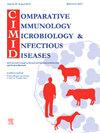犬瘟热病毒血凝素基因和fsp编码区的系统发育和分子分析:对新型疫苗开发的见解。
IF 2
3区 农林科学
Q4 IMMUNOLOGY
Comparative Immunology Microbiology and Infectious Diseases
Pub Date : 2025-01-11
DOI:10.1016/j.cimid.2024.102292
引用次数: 0
摘要
犬瘟热病毒(CDV)引起高度传染性和致命的疾病,在广泛的肉食性和非肉食性物种。本研究旨在对接种犬的CDV分离株的血凝素(H)基因和fsp编码区进行遗传研究。H基因和fsp编码区的系统发育分析表明,我们的病毒属于arctic -样谱系,与伊朗常用的两种疫苗株(America-1谱系株)不同。我们的数据显示所研究的病毒之间的H基因序列高度相似。病毒H基因对疫苗株的多序列比对显示,核苷酸和氨基酸的同源性分别为91.3 ~ 95.6% %和89.9 ~ 94.4 %。我们的发现发现了一个潜在的重组断点,发生在密码子520-607之间,以及三个阳性选择位点,包括H基因中的残基415,547和549。与美洲-1疫苗株相比,血凝和套索表位(HNE)的B细胞表位存在显著差异。此外,研究病毒的H基因有8个n -糖基化位点,比美国-1疫苗株多。我们的结果证实了北极样谱系的环流可能是一个普遍的谱系。尽管广泛接种疫苗,但它并不能提供针对CDV感染的全面保护。由于我们的病毒和常用疫苗株之间的抗原差异,似乎需要一种新的疫苗株来预防和准备对北极样CDV感染的充分保护。本文章由计算机程序翻译,如有差异,请以英文原文为准。
Phylogenetic and molecular analysis of hemagglutinin gene and Fsp-coding region of canine distemper virus: Insight into novel vaccine development
Canine distemper virus (CDV) causes a highly contagious and lethal disease in a vast range of carnivorous and non-carnivorous species. The study aimed to genetically investigate the hemagglutinin (H) gene and Fsp-coding region of CDV isolates from vaccinated dogs. Phylogenetic analysis of the H gene and Fsp-coding region showed that our viruses belonged to the Arctic-like lineage which was distinct from two commonly used vaccine strains (America-1 lineage strains) in Iran. Our data presented a high similarity between the H gene sequences of studied viruses. The multiple sequence alignment of the H gene of our viruses against vaccine strains revealed 91.3–95.6 % and 89.9–94.4 % in the level of nucleotide and amino acid identity, respectively. Our finding identified a potential recombination breakpoint occurring between codons 520–607, along with three positive selection sites including residues 415,547, and 549 among the H gene using the Data Monkey platform. A significant variation of B cell epitopes was found in Hemagglutinating and noose epitope (HNE), with respect to America-1 vaccine strains. Moreover, the H genes of studied viruses had 8 N-glycosylation sites, which is more than the America-1 vaccine strains. Our results confirmed that the circulation of Arctic-like lineage may be a prevalent lineage. Despite widespread vaccination, it does not provide full protection against CDV infection. Due to antigenic differences between our viruses and commonly used vaccine strains, it seems a novel vaccine strain is needed to prevent and prepare full protection against Arctic-like CDV infection.
求助全文
通过发布文献求助,成功后即可免费获取论文全文。
去求助
来源期刊
CiteScore
4.60
自引率
0.00%
发文量
102
审稿时长
40 days
期刊介绍:
Comparative Immunology, Microbiology & Infectious Diseases aims to respond to the concept of "One Medicine" and to provide a venue for scientific exchange. Based on the concept of "Comparative Medicine" interdisciplinary cooperation between specialists in human and animal medicine is of mutual interest and benefit. Therefore, there is need to combine the respective interest of physicians, veterinarians and other health professionals for comparative studies relevant to either human or animal medicine .
The journal is open to subjects of common interest related to the immunology, immunopathology, microbiology, parasitology and epidemiology of human and animal infectious diseases, especially zoonotic infections, and animal models of human infectious diseases. The role of environmental factors in disease emergence is emphasized. CIMID is mainly focusing on applied veterinary and human medicine rather than on fundamental experimental research.

 求助内容:
求助内容: 应助结果提醒方式:
应助结果提醒方式:


